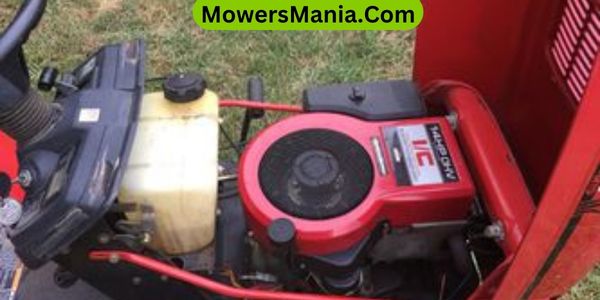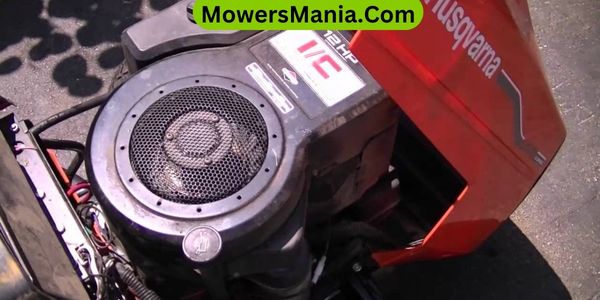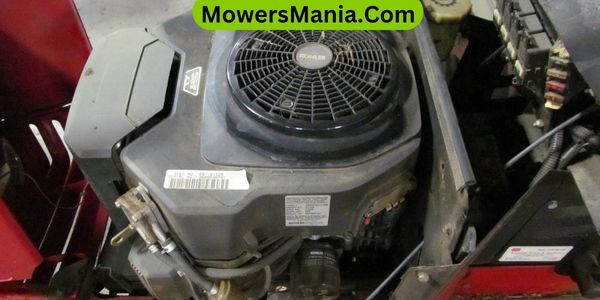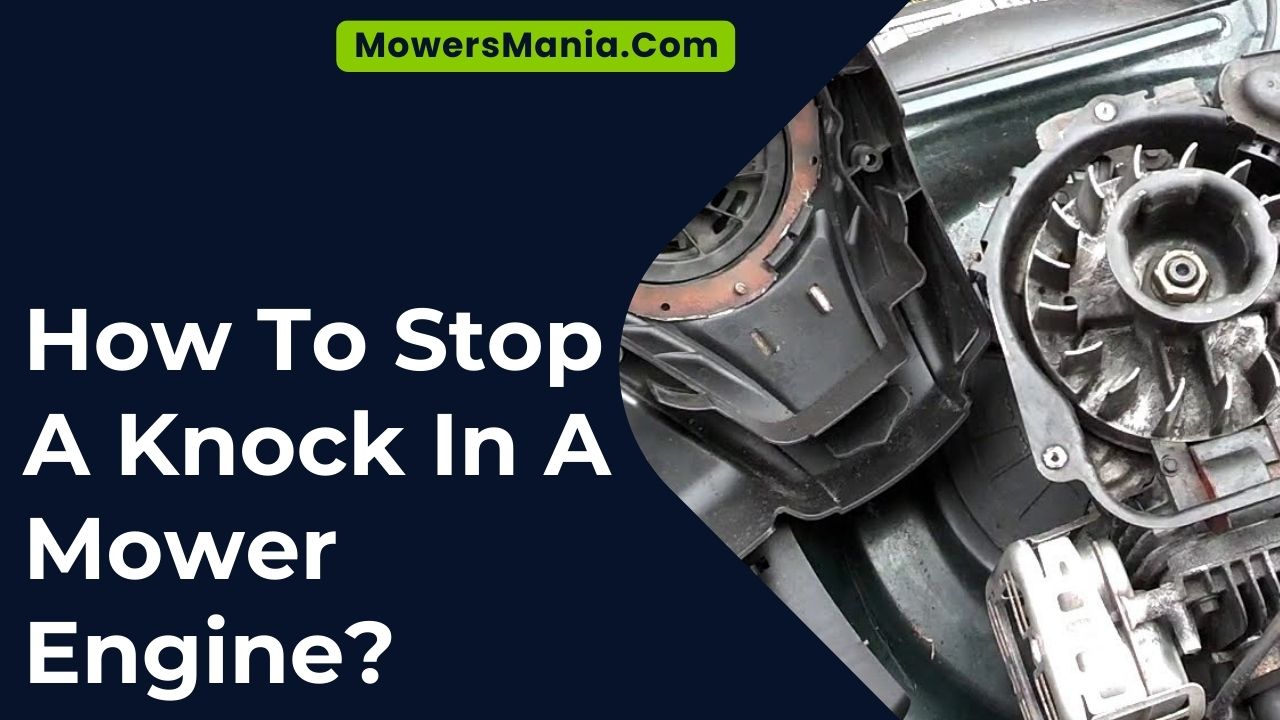Feeling frustrated by the frustrating knock in your mower engine? Don’t worry, you can tackle this problem with a few simple steps.
Identifying the cause of the knock is the first crucial step in putting an end to it. By checking oil levels and quality, inspecting the spark plug, adjusting valve clearance, and addressing fuel issues, you can silence that bothersome knock and get your mower running smoothly again.

Let’s dive in and get that engine purring like a kitten!
Identifying the Cause of the Knock
To identify the cause of the knock in your mower engine, start by checking for loose or damaged components. Begin with the easiest things to fix.
Ensure that all the bolts and screws are tight, especially those holding the engine components together. Look for any visible damage to the blades, flywheel, or any other moving parts. If everything seems intact, move on to the next step.
Next, check the oil level. Low oil can lead to increased friction and cause knocking sounds. If the oil level is low, top it up to the recommended level and run the engine again to see if the knock persists.
If the knock continues, it’s time to inspect the spark plug. A worn-out spark plug can cause irregular combustion, resulting in knocking noises. Remove the spark plug and check for signs of wear or damage. If necessary, replace it with a new one.
Checking Oil Levels and Quality
Check the oil levels and quality in your mower engine to ensure proper lubrication and prevent knocking sounds.
Here’s how to do it:
- Check the Oil Level:
Start by locating the oil dipstick on your mower engine. Pull it out, wipe it clean, reinsert it, and then pull it out again to check the oil level. Add more oil if it’s below the recommended level.
- Inspect the Oil Quality:
Examine the color and consistency of the oil. Fresh, clean oil should have a translucent amber color. If the oil appears dark or gritty, it’s time for an oil change.
- Change the Oil Regularly:
Regular oil changes are crucial for maintaining a healthy engine. Refer to your mower’s manual for the recommended oil change intervals.
- Use the Right Type of Oil:
Ensure that you’re using the appropriate type of oil for your mower engine. Using the wrong oil can lead to poor lubrication and increased risk of engine knocking.
Inspecting the Spark Plug

Inspect the spark plug in your mower engine to ensure proper ignition and address potential causes of knocking. Start by disconnecting the spark plug wire and removing the spark plug with a socket wrench.
Examine the spark plug for signs of damage, such as cracks or carbon buildup. If the spark plug appears worn or dirty, it may need to be cleaned or replaced. Use a wire brush to clean the spark plug, or replace it with a new one if necessary.
Check the electrode gap using a feeler gauge, ensuring it matches the manufacturer’s specifications. A wider or narrower gap than recommended can affect engine performance.
Additionally, inspect the spark plug wire for any damage or wear and replace it if needed.
Properly reinstall the spark plug, ensuring it’s tightened securely but not over-tightened.
This simple inspection and maintenance task can have a significant impact on the smooth operation of your mower engine, preventing knocking and ensuring reliable ignition for optimal performance.
Adjusting Valve Clearance
When should you adjust the valve clearance in your mower engine to prevent knocking? It’s important to check and adjust the valve clearance on your mower engine if you notice a knocking sound or if the engine isn’t running smoothly.
Here’s how to adjust the valve clearance properly:
Addressing Fuel Issues

Once you have addressed any potential valve clearance issues, move on to addressing fuel issues in your mower engine to resolve any knocking sound.
First, check the fuel quality and ensure that you’re using fresh, clean fuel. Stale or contaminated fuel can cause engine knocking. Drain the old fuel and replace it with fresh gasoline.
Next, inspect the fuel filter for any clogs or debris. A dirty fuel filter can restrict fuel flow to the engine, causing knocking or misfiring. Replace the fuel filter if it appears dirty or clogged.
After checking the fuel filter, examine the carburetor for any buildup or blockages. Clean the carburetor thoroughly to ensure proper fuel delivery to the engine.
Additionally, check the fuel lines for any cracks, leaks, or blockages. Damaged or clogged fuel lines can disrupt fuel flow and lead to engine knocking. Replace any damaged fuel lines and ensure that the fuel system is free from obstructions.
Frequently Asked Questions [FAQs]
Can Using Low-Quality Gasoline Cause a Knocking Sound in the Mower Engine?
Using low-quality gasoline can cause a knocking sound in the mower engine. You should switch to a higher octane fuel to prevent this issue. Regular maintenance and using high-quality fuel can help your engine run smoothly.
What Are Some Common Signs of a Worn-Out Piston or Connecting Rod That Could Be Causing the Knocking Sound?
If you notice a worn-out piston or connecting rod causing a knocking sound in your mower engine, it’s crucial to address it promptly. Ignoring these signs could lead to more severe damage and costly repairs down the line.
How Often Should the Mower’s Air Filter Be Replaced to Prevent Engine Knocking?
You should replace the mower’s air filter every season to prevent engine knocking. Neglecting this maintenance can lead to reduced engine performance and potential damage. Regular filter changes ensure proper airflow and protect the engine.
Is It Possible for a Loose or Damaged Flywheel to Create a Knocking Noise in the Mower Engine?
Yes, it’s possible for a loose or damaged flywheel to create a knocking noise in the mower engine. You should check the flywheel for any signs of damage or looseness and address it promptly to prevent further issues.
Are There Any Specific Maintenance Tasks That Can Help Prevent Future Knocking Issues in the Mower Engine?
To prevent future knocking issues in your mower engine, ensure regular maintenance tasks like checking and tightening bolts, changing oil and filters, and inspecting for any loose or damaged parts. Following the manufacturer’s maintenance guidelines is essential.
Conclusion
So, if you want to stop a knock in your mower engine, make sure to:
- Identify the cause of the knock
- Check your oil levels and quality
- Inspect the spark plug
- Adjust valve clearance
- Address any fuel issues
By following these steps, you can keep your mower engine running smoothly and efficiently.



